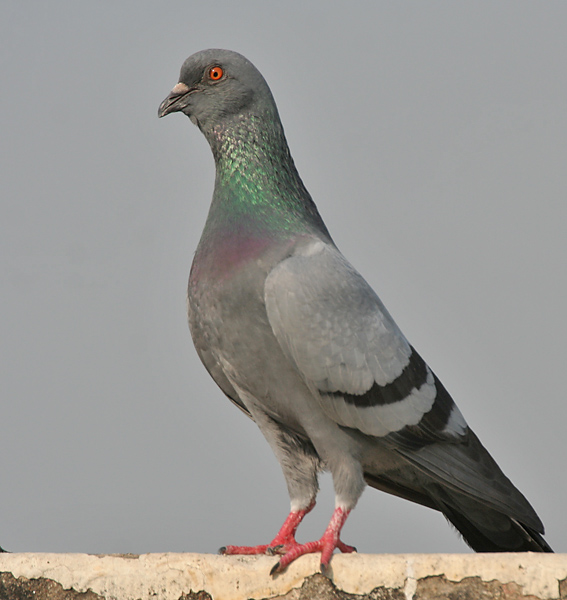 Blue Rock Pigeon (Columba livia). Photo by J. M. Garg, courtesy of Wikipedia |
BIRDS IN ARABIAN CAVES
By Michael C. Jennings
Photos ©2008 by John and Susy Pint unless otherwise credited
Updated September, 2013
 Blue Rock Pigeon (Columba livia). Photo by J. M. Garg, courtesy of Wikipedia |
|
Mike Jennings is Coordinator of the Atlas of the Breeding Birds of Arabia (ABBA) and Editor of the Phoenix newsletter (see below). He is interested in hearing from anyone with records of birds from the Arabian Peninsula |
John and Susy Pint are leaders in the exploration of caves in Arabia (see their website http://www.saudicaves.com for details of some amazing underground places and adventures) and have reported a number of interesting bird observations during their speleological pursuits. For example, Rock Doves Columba livia have been observed in many limestone caves such as Dahl Abu Jirfan and appropriately named Dove Cave, which are located north of Riyadh as well as in many of the limestone caves of the far north, such as Black Scorpion Cave in the Habikah area. Although the study of lava tubes in Saudi Arabia has scarcely begun, it appears that these, too, are home to Rock Doves. This has proven to be the case in Ghostly Cave in Harrat Kishb, Kahf Al Shuwaymis in Harrat Ithnayn, and the Umm Jirsan System in Harrat Khaybar.
|
Note: Lava tubes are formed when molten lava runs downhill during an eruption.
As the stream becomes solidified on the surface, the flow continues like a
drainpipe underground and if the supply suddenly stops, the liquid lava runs out
of the bottom leaving an empty tube. Some of these tubes in Arabia have been
3 km long and over 40 m deep and helicopter surveys indicate there may be
others up to 50 kilometers long.... |
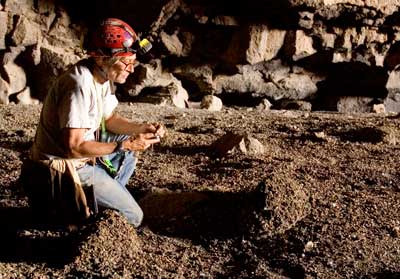 |
| In certain vertical caves which have rarely or never been visited by animals or
humans, Rock Doves Columba livia regularly nest on the floor where they
obviously feel safe. Hundreds of Rock Doves were found breeding 100 m below the
surface in the pit of Dharb al Najem, near Majma’a in central Saudi Arabia and
nesting 75 m below the surface on the floor of the Dahl Abalhol located 206 km
east of Riyadh.
|
 |
 |
Thousands of Rock-Dove tracks cover the sand near Dahl Abalhol
GUANOMITES
| ...In addition, Arabian Rock Doves are the inspiration for a completely new
speleological term ‘guanomites’. These are curious dove-dropping stalagmites
that grow below roost sites up to a man’s height on the dry, undisturbed floor of
desert caves and are probably hundreds, if not thousands, of years in the
making.
|
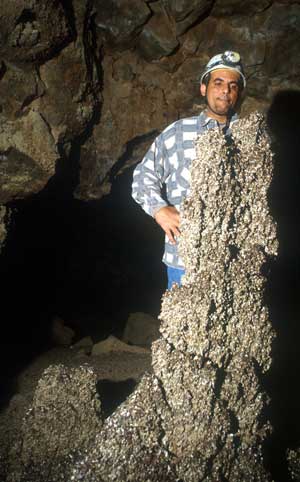 |
SWIFTS
| Working with Saudi Geological Survey, the Pints have also explored the
longest lava tubes that exist in the Middle East in the harrats of western
Arabia, including Umm Jirsan System in the Harrat Khaybar, which turned up Little Swifts (Apus
affinis) nesting at least 20 m into the tube as well as several reports of owls, not to
mention wolves and hyaenas.
|
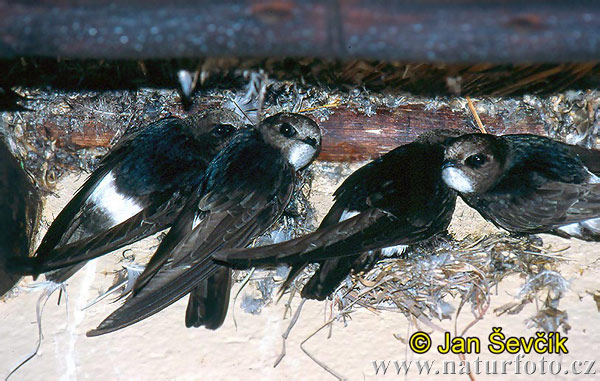 |
|
|
Swifts were found exclusively in the western (Wolf Den) Passage of Umm Jirsan,
presently the longest lava tube system found on the Arabian Peninsula (1.5 km)
|
This Little Swift nest was found in Umm Jirsan Cave. It is interesting to note that plastic fibres from feed and fertilizer bags (green strands in the picture) now seem to be a major source of materials for nest-building in the desert.
|
 |
|
|
At sunset, Little Swifts dart through the air above the 80-m-wide entrance
to Umm Jirsan Cave. A few hours later, they are replaced by bats.
  . .
|
| ...Caves are very often undisturbed, ancient and special habitats and although
there are no records from Arabia of birds penetrating deep into caves, to live
or breed in total darkness, like the Oilbird Steatornis caripensis of South
America, a number of species are shown on the ABBA database as breeding in caves
in Arabia...
|
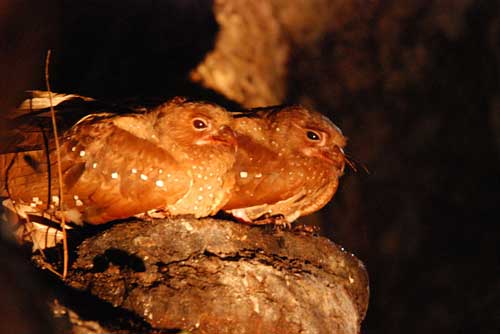 |
...Pallid Swifts Apus pallidus are well known to nest in the roof of the famous Dahl Hit just south of Riyadh. (This was the cave where Abdulaziz Ibn Saud watered his camels and his men rested the night before he captured Riyadh early in the 20th century). Little Swifts Apus affinis have been reported nesting in cave ceilings in Yemen and the Hedjaz. Forbes-Watson’s Swift Apus berliozi nest in small coastal caves in Dhofar and Socotra...
OWLS
As might be imagined, owls are regular cave goers, the first Hume’s Owl Strix
butleri recorded in central Arabia in the 1970s was found roosting inside a 10 m
long cave, Barn Owls Tyto alba have been found in a cave on ‘the jebal’ of
Bahrain, Spotted Eagle Owls Bubo africanus have been collected from a cave in
the Hedjaz and Desert Eagle Owl Bubo ascalaphus collected from caves in the
Eastern Province.
Perhaps the most commonly recorded cave dwelling owl is the Little Owl Athene
noctua which has been reported from this habitat in western and central Saudi
Arabia and at Dahl al Misfir Cave, Qatar.
| The Little Owl is probably the most widespread owl in Arabia occurring almost
everywhere from high mountain in the south-west to the Empty Quarter. It is
rather scarce in the north probably mainly because of a shortage of suitable
nesting sites. It is particularly common on some of the new irrigated farms in
central Arabia. It is one of the few owls that can be seen in daylight - it has
a habit of sitting out in the late afternoon sun by its hole; it is also a bit
slow to go to bed and can often be seen until about mid morning. Home is
virtually any hole or crevice. This can be in a tree, a rock, a cave, an old
vehicle and once even a disused oil drum lying in the desert. Like most of its
kin it hunts at night. It feeds on small mammals such as rodents, a few birds
but also takes lots of reptiles such as skinks, geckos, snakes and invertebrates
like beetles, scorpions, grasshoppers and solifugids.
This baby Little Owl was found living with its mother in B31 Cave, 200 km NE of Riyadh. Photo courtesy of Mahmoud Al-Shanti. |
 |
OTHER CAVE-DWELLING BIRDS
The ceiling of many caves are also particularly favoured nesting sites of Pale
Crag Martin Pytonoprogne obsoleta and Red -rumped Swallow Cecropis duarica...
| ...On Socotra both the Socotra and Somali Starlings Onychognathus blythii (like
Tristram’s Starling O. tristramii on the mainland), have used caves for nesting...
|
 |
...The sea-facing caves and fissures of the island are the only known breeding sites for the endemic Jouanin’s Petrel Bulweria fallax. Local people used to harvest them and have reported that they could take 30 young from a single good cave in a night.
|
|
 |
RAPTORS
| A whole range of raptors find inaccessible caves good places to breed and roost
and there are breeding records of Egyptian Vulture Neophron percnopterus,
Griffon Vulture Gyps fulvus, Bonelli’s Eagle Hieraaetus fasciatus, Long-legged
Buzzard Buteo rufinus, as well as four species of falcon, Kestrel Falco
tinnunculus, Sooty Falcon F. concolor, Lanner F. biamicus and Barbary F.
pelegrinoides.
|
 |
THE STALACTITE DRINKER
Perhaps the most famous bird cave in Arabia is Tawi Atair in southern
Oman, a vertical sinkhole with water at the bottom that has created (or
retained) a special shady habitat which was, for a long time, the only place outside of
Yemen that the Yemen Serin Serinus yemenensis could be found, 1000 km from its
homeland. The serins seem to spend their lives in or around the hole, nesting in
its crevices, finding food and drinking from stalactites.
THE ABBA PROJECT
ABBA stands for Atlas of the Breeding Birds of Arabia.
The ABBA Project has,
since 1984, been collecting information on the status and distribution of
Arabian breeding birds for the purposes of compiling a definitive atlas of the
breeding range of these birds. In 1995 An Interim atlas of the Breeding Birds of
Arabia was published and work is now continuing on the final atlas. This is
being written with the help of a number of authors with a special knowledge of
Arabian birds.
Each year the project publishes a newsletter The Phoenix (ISSN 0268-487X), which
is available on subscription (See contact information below).
This article is an
expanded version of Birds in Caves by Michael C. Jennings, which appeared
in the PHOENIX, Number 24, January 2008
|
Contact information for Mike Jennings: Email: Qarabianbirds@dsl.pipex.com NOTE: Please remove the Q before using this email address! |
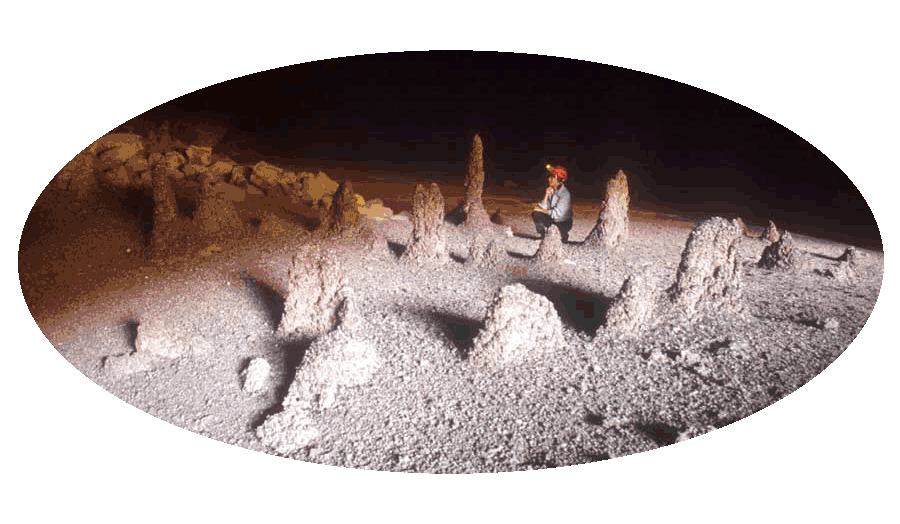
Susy Pint among the Guanomites (Ghostly Cave, Saudi Arabia)